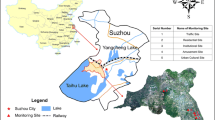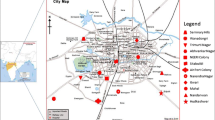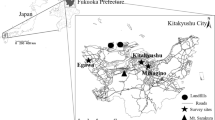Abstract
Carbon dioxide (CO2) and methane (CH4) are the two major greenhouse gases (GHGs) in the atmosphere that contribute to global warming. Vehicle emissions on expressways cannot be neglected in the megacity Shanghai because oil accounts for 41% of the total primary energy consumption, and the expressway network carries 60% of the total traffic volume. The spatial distributions of CO2 and CH4 concentrations were monitored in situ on the expressways and in road tunnels using a mobile vehicle. The average CO2 and CH4 concentrations were 472.88 ± 34.48 ppm and 2033 ± 54 ppb on the expressways and 1308.92 ± 767.48 ppm and 2182 ± 112 ppb in the road tunnels in Shanghai, respectively. The highest CO2 and CH4 concentrations appeared on the Yan’an Elevated Road and the North-South Elevated Road, respectively, while their lowest values both occurred on the Huaxia Elevated Road passing through the suburban area. The hotspots of CO2 and CH4 were not consistent, suggesting that they have different sources. Tunnels had a “push-pull effect” on GHGs, and the traffic-congested Yan’an East Road Tunnel showed a dramatically increasing trend of GHG concentration from the entrance to the exit. This traffic-congested tunnel could accumulate a very high concentration of GHGs as well as other pollutants, which could introduce unhealthy conditions for both drivers and passengers. Significant correlations between CO2 and CH4 mostly appeared on the expressways and in the tunnels in Shanghai, suggesting the influences of vehicle exhaust. ΔCH4/ΔCO2 (the slope of the linear regression between CH4 and CO2) and the CH4/CO2 ratio could be used as indicators of vehicle exhaust sources because it increases from sources (e.g., road tunnels) to the observatories in the urban area.




Similar content being viewed by others
References
Ao X, Grimmond CSB, Chang Y, Liu D, Tang Y, Hu P, Wang Y, Zou J, Tan J (2016) Heat, water and carbon exchanges in the tall megacity of Shanghai: challenges and results. Int J Climatol 36:4608–4624. https://doi.org/10.1002/joc.4657
Atherton E, Risk D, Fougère C, Lavoie M, Marshall A, Werring J, Williams JP, Minions C (2017) Mobile measurement of methane emissions from natural gas developments in northeastern British Columbia, Canada. Atmos Chem Phys 17:12405–12420. https://doi.org/10.5194/acp-17-12405-2017
Canadell JG, Ciais P, Dhakal S, Dolman H, Friedlingstein P, Gurney KR, Held A, Jackson RB, le Quéré C, Malone EL, Ojima DS, Patwardhan A, Peters GP, Raupach MR (2010) Interactions of the carbon cycle, human activity, and the climate system: a research portfolio. Curr Opin Environ Sustain 2:301–311. https://doi.org/10.1016/j.cosust.2010.08.003
Chan CK, Yao X (2008) Air pollution in mega cities in China. Atmos Environ 42:1–42. https://doi.org/10.1016/j.atmosenv.2007.09.003
El-Fadel M, Hashisho Z (2001) Vehicular emissions in roadway tunnels: a critical review. Crit Rev Environ Sci Technol 31:125–174. https://doi.org/10.1080/20016491089190
Fiore AM, Naik V, Spracklen DV, Steiner A, Unger N, Prather M, Bergmann D, Cameron-Smith PJ, Cionni I, Collins WJ, Dalsøren S, Eyring V, Folberth GA, Ginoux P, Horowitz LW, Josse B, Lamarque JF, MacKenzie IA, Nagashima T, O'Connor FM, Righi M, Rumbold ST, Shindell DT, Skeie RB, Sudo K, Szopa S, Takemura T, Zeng G (2012) Global air quality and climate. Chem Soc Rev 41:6663–6683. https://doi.org/10.1039/C2CS35095E
Ghosh A, Patra PK, Ishijima K, Umezawa T, Ito A, Etheridge DM, Sugawara S, Kawamura K, Miller JB, Dlugokencky EJ, Krummel PB, Fraser PJ, Steele LP, Langenfelds RL, Trudinger CM, White JWC, Vaughn B, Saeki T, Aoki S, Nakazawa T (2015) Variations in global methane sources and sinks during 1910–2010. Atmos Chem Phys 15:2595–2612. https://doi.org/10.5194/acp-15-2595-2015
Ho KF, Ho SSH, Lee SC, Cheng Y, Chow JC, Watson JG, Louie PKK, Tian L (2009a) Emissions of gas- and particle-phase polycyclic aromatic hydrocarbons (PAHs) in the Shing Mun Tunnel, Hong Kong. Atmos Environ 43:6343–6351. https://doi.org/10.1016/j.atmosenv.2009.09.025
Ho KF, Lee SC, Ho WK, Blake DR, Cheng Y, Li YS, Ho SSH, Fung K, Louie PKK, Park D (2009b) Vehicular emission of volatile organic compounds (VOCs) from a tunnel study in Hong Kong. Atmos Chem Phys 9:7491–7504. https://doi.org/10.5194/acp-9-7491-2009
Huang X, Wang T, Talbot R, Xie M, Mao H, Li S, Zhuang B, Yang X, Fu C, Zhu J, Huang X, Xu R (2015) Temporal characteristics of atmospheric CO2 in urban Nanjing, China. Atmos Res 153:437–450. https://doi.org/10.1016/j.atmosres.2014.09.007
IEA (2012) International Energy Agency: world energy outlook 2012, Paris, France
IPCC (2014) Climate change 2014: synthesis report. Contribution of Working Groups I. II and III to the fifth assessment report of the Intergovernmental Panel on Climate Change. IPCC, Geneva, Switzerland
Jia B, Xie Z, Zeng Y, Wang L, Wang Y, Xie J, Xie Z (2015) Diurnal and seasonal variations of CO2 fluxes and their climate controlling factors for a subtropical forest in Ningxiang. Adv Atmos Sci 32:553–564. https://doi.org/10.1007/s00376-014-4069-4
Kirschke S, Bousquet P, Ciais P, Saunois M, Canadell JG, Dlugokencky EJ, Bergamaschi P, Bergmann D, Blake DR, Bruhwiler L, Cameron-Smith P, Castaldi S, Chevallier F, Feng L, Fraser A, Heimann M, Hodson EL, Houweling S, Josse B, Fraser PJ, Krummel PB, Lamarque JF, Langenfelds RL, le Quéré C, Naik V, O'Doherty S, Palmer PI, Pison I, Plummer D, Poulter B, Prinn RG, Rigby M, Ringeval B, Santini M, Schmidt M, Shindell DT, Simpson IJ, Spahni R, Steele LP, Strode SA, Sudo K, Szopa S, van der Werf GR, Voulgarakis A, van Weele M, Weiss RF, Williams JE, Zeng G (2013) Three decades of global methane sources and sinks. Nat Geosci 6:813–823. https://doi.org/10.1038/ngeo1955
Le Quéré C et al (2018) Global carbon budget 2018. Earth Syst Sci Data 10:2141–2194. https://doi.org/10.5194/essd-10-2141-2018
Lei X-n, Bian J-w, Xiu G-l, Hu X-f, Gu X-s, Bian Q-g (2017) The mobile monitoring of black carbon and its association with roadside data in the Chinese megacity of Shanghai. Environ Sci Pollut Res 24:7482–7489. https://doi.org/10.1007/s11356-017-8454-2
Li N, Lu Y, Liao H, He Q, Li J, Long X (2018) WRF-Chem modeling of particulate matter in the Yangtze River Delta region: source apportionment and its sensitivity to emission changes. PLoS One 13:e0208944. https://doi.org/10.1371/journal.pone.0208944
Liu M, Zhu X, Pan C, Chen L, Zhang H, Jia W, Xiang W (2016) Spatial variation of near-surface CO2 concentration during spring in Shanghai. Atmos Pollut Res 7:31–39. https://doi.org/10.1016/j.apr.2015.07.002
Liu L, Tans PP, Xia L, Zhou L, Zhang F (2018) Analysis of patterns in the concentrations of atmospheric greenhouse gases measured in two typical urban clusters in China. Atmos Environ 173:343–354. https://doi.org/10.1016/j.atmosenv.2017.11.023
Liu M, Meng Z, She Q, Zhu X, Wei N, Peng X, Xu Q (2019) Spatial variability and determinants of atmospheric methane concentrations in the metropolitan city of Shanghai, China. Atmos Environ 214:116834. https://doi.org/10.1016/j.atmosenv.2019.116834
Masiol M, Harrison RM (2014) Aircraft engine exhaust emissions and other airport-related contributions to ambient air pollution: a review. Atmos Environ 95:409–455. https://doi.org/10.1016/j.atmosenv.2014.05.070
Mitchell LE, Crosman ET, Jacques AA, Fasoli B, Leclair-Marzolf L, Horel J, Bowling DR, Ehleringer JR, Lin JC (2018) Monitoring of greenhouse gases and pollutants across an urban area using a light-rail public transit platform. Atmos Environ 187:9–23. https://doi.org/10.1016/j.atmosenv.2018.05.044
Nam EK, Jensen TE, Wallington TJ (2004) Methane emissions from vehicles. Environ Sci Technol 38:2005–2010. https://doi.org/10.1021/es034837g
Popa ME, Vollmer MK, Jordan A, Brand WA, Pathirana SL, Rothe M, Röckmann T (2014) Vehicle emissions of greenhouse gases and related tracers from a tunnel study: CO:CO2, N2O:CO2, CH4:CO2, O2:CO2 ratios, and the stable isotopes 13C and18O in CO2 and CO. Atmos Chem Phys 14:2105–2123. https://doi.org/10.5194/acp-14-2105-2014
Postorino MN, Mantecchini L (2014) A transport carbon footprint methodology to assess airport carbon emissions. J Air Transp Manag 37:76–86. https://doi.org/10.1016/j.jairtraman.2014.03.001
Santoni GW, Lee BH, Wood EC, Herndon SC, Miake-Lye RC, Wofsy SC, McManus JB, Nelson DD, Zahniser MS (2011) Aircraft emissions of methane and nitrous oxide during the alternative aviation fuel experiment. Environ Sci Technol 45:7075–7082. https://doi.org/10.1021/es200897h
Satterthwaite D (2008) Cities’ contribution to global warming: notes on the allocation of greenhouse gas emissions. Environ Urban 20:539–549. https://doi.org/10.1177/0956247808096127
Saunois M, Bousquet P, Poulter B, Peregon A, Ciais P, Canadell JG, Dlugokencky EJ, Etiope G, Bastviken D, Houweling S, Janssens-Maenhout G, Tubiello FN, Castaldi S, Jackson RB, Alexe M, Arora VK, Beerling DJ, Bergamaschi P, Blake DR, Brailsford G, Brovkin V, Bruhwiler L, Crevoisier C, Crill P, Covey K, Curry C, Frankenberg C, Gedney N, Höglund-Isaksson L, Ishizawa M, Ito A, Joos F, Kim HS, Kleinen T, Krummel P, Lamarque JF, Langenfelds R, Locatelli R, Machida T, Maksyutov S, McDonald KC, Marshall J, Melton JR, Morino I, Naik V, O'Doherty S, Parmentier FJW, Patra PK, Peng C, Peng S, Peters GP, Pison I, Prigent C, Prinn R, Ramonet M, Riley WJ, Saito M, Santini M, Schroeder R, Simpson IJ, Spahni R, Steele P, Takizawa A, Thornton BF, Tian H, Tohjima Y, Viovy N, Voulgarakis A, van Weele M, van der Werf GR, Weiss R, Wiedinmyer C, Wilton DJ, Wiltshire A, Worthy D, Wunch D, Xu X, Yoshida Y, Zhang B, Zhang Z, Zhu Q (2016) The global methane budget 2000–2012. Earth Syst Sci Data 8:697–751. https://doi.org/10.5194/essd-8-697-2016
Shan Y, Guan D, Zheng H, Ou J, Li Y, Meng J, Mi Z, Liu Z, Zhang Q (2018) China CO2 emission accounts 1997–2015. Sci Data 5:170201. https://doi.org/10.1038/sdata.2017.201
Shanghai Statistical Bureau (2018) http://wwwstats-shgovcn/html/sjfb/tjnj/, obtained at 4th May, 2019
Sun J, Li T, Li F, Chen F (2016) Analysis of safety factors for urban expressways considering the effect of congestion in Shanghai, China. Accid Anal Prev 95:503–511. https://doi.org/10.1016/j.aap.2015.12.011
Sun W, Deng L, Wu G, Wu L, Han P, Miao Y, Yao B (2019) Atmospheric monitoring of methane in Beijing using a mobile observatory. Atmosphere 10:554. https://doi.org/10.3390/atmos10090554
Tans P, Keeling R (2018) Tans, Pieter, NOAA/ESRL (www.esrl.noaa.gov/gmd/ccgg/trends/) and Ralph Keeling, Scripps Institution of Oceanography (scrippsco2. ucsd. edu/). .
Wang X, Ho KF, Chow JC, Kohl SD, Chan CS, Cui L, Lee SCF, Chen LWA, Ho SSH, Cheng Y, Watson JG (2018) Hong Kong vehicle emission changes from 2003 to 2015 in the Shing Mun Tunnel. Aerosol Sci Technol 52:1085–1098. https://doi.org/10.1080/02786826.2018.1456650
Wei C, Bandowe BAM, Han Y, Cao J, Zhan C, Wilcke W (2015a) Polycyclic aromatic hydrocarbons (PAHs) and their derivatives (alkyl-PAHs, oxygenated-PAHs, nitrated-PAHs and azaarenes) in urban road dusts from Xi’an, Central China. Chemosphere 134:512–520. https://doi.org/10.1016/j.chemosphere.2014.11.052
Wei C, Han Y, Bandowe BAM, Cao J, Huang RJ, Ni H, Tian J, Wilcke W (2015b) Occurrence, gas/particle partitioning and carcinogenic risk of polycyclic aromatic hydrocarbons and their oxygen and nitrogen containing derivatives in Xi’an, central China. Sci Total Environ 505:814–822. https://doi.org/10.1016/j.scitotenv.2014.10.054
Wei C, Wang M, Fu Q, Dai C, Huang R, Bao Q (2020a) Temporal characteristics of greenhouse gases (CO2 and CH4) in the megacity Shanghai, China: association with air pollutants and meteorological conditions. Atmos Res 235:104759. https://doi.org/10.1016/j.atmosres.2019.104759
Wei C, Wang MH, Fu QY, Dai C, Huang R, Bao Q (2020b) Temporal characteristics and potential sources of black carbon in megacity Shanghai, China. J Geophys Res-Atmos 125:e2019JD031827. https://doi.org/10.1029/2019JD031827
Westerdahl D, Fruin S, Sax T, Fine PM, Sioutas C (2005) Mobile platform measurements of ultrafine particles and associated pollutant concentrations on freeways and residential streets in Los Angeles. Atmos Environ 39:3597–3610. https://doi.org/10.1016/j.atmosenv.2005.02.034
Wiesen P, Kleffmann J, Kurtenbach R, Becker KH (1994) Nitrous oxide and methane emissions from aero engines. Geophys Res Lett 21:2027–2030. https://doi.org/10.1029/94gl01709
WMO (2018) WMO greenhouse gas bulletin: the state of greenhouse gases in the atmosphere based on global observations through 2017, accessed from https://library.wmo.int/doc_num.php?explnum_id = 5455
Yuan X, Liu X, Zuo J (2015) The development of new energy vehicles for a sustainable future: a review. Renew Sust Energ Rev 42:298–305. https://doi.org/10.1016/j.rser.2014.10.016
Zhang Y, Wang X, Li G, Yang W, Huang Z, Zhang Z, Huang X, Deng W, Liu T, Huang Z, Zhang Z (2015) Emission factors of fine particles, carbonaceous aerosols and traces gases from road vehicles: recent tests in an urban tunnel in the Pearl River Delta, China. Atmos Environ 122:876–884. https://doi.org/10.1016/j.atmosenv.2015.08.024
Acknowledgments
We thank the editors and two anonymous reviewers for their valuable comments. We also thank Li Shang, Cheng Dai, and Zheng Lyu from Shanghai Advanced Research Institute, Chinese Academy of Sciences, for their help in on-road observation and manuscript comments.
Funding
This research was funded by the Chinese Academy of Sciences, China (ZDRW-ZS-2019-1-3-2, 2016-999999-65-01-000696-03), the National Key R&D Program of China, MOST, China (2016YFA0602602, 2016YFA0602603, 2017YFA0605302), Shanghai Science and Technology Committee, China (18DZ1204902, 15DZ1170600), and National Natural Science Foundation of China, China (41503119, 51778601).
Author information
Authors and Affiliations
Corresponding author
Additional information
Responsible Editor: Philippe Garrigues
Publisher’s note
Springer Nature remains neutral with regard to jurisdictional claims in published maps and institutional affiliations.
Rights and permissions
About this article
Cite this article
Wei, C., Wang, M. Spatial distribution of greenhouse gases (CO2 and CH4) on expressways in the megacity Shanghai, China. Environ Sci Pollut Res 27, 31143–31152 (2020). https://doi.org/10.1007/s11356-020-09372-1
Received:
Accepted:
Published:
Issue Date:
DOI: https://doi.org/10.1007/s11356-020-09372-1




